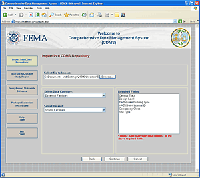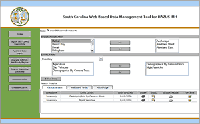Comprehensive Data Management System (CDMS)
New Tool in HAZUS-MH MR3

The CDMS is a complimentary tool to HAZUS-MH MR3 that provides users with the capability to update and manage statewide datasets, which are currently used to support analysis in HAZUS-MH. The CDMS will function as a single user or shared desktop application. Click here to view larger graphic.
Currently, HAZUS-MH users are required to undertake a large amount of manual effort to incorporate new data into the statewide datasets according to their predefined formats. To reduce this effort, the CDMS will streamline and automate raw data processing, the conversion of external data sources into HAZUS-MH compliant data, and the transfer of data into and out of the statewide datasets. Processing site-specific level and aggregate information at the census block and tract levels will be supported. All new data brought into the system will be validated.
Once data are imported into the statewide datasets, the CDMS will allow users to query, sort, export and print information. A backwards compatibility utility will be in place for upgrading previous versions of HAZUS-MH databases to HAZUS-MH MR3. The CDMS will replace the Building Information Tool (BIT) and Inventory Collection and Survey Tool (InCAST) that are currently available on HAZUS-MH DVD.
Now Available!! Download CDMS Version 2.0.
CDMS Version 2.0 Release Notes
CDMS Modules
The CDMS is comprised of four modules: the aggregate, site-specific, backward compatibility, and import modules. The aggregate, site-specific, and backward compatibility modules work together. Raw data can be used to generate aggregated data, and if the raw data has location information, then site specific data can also be generated at the same time. Similarly, aggregated data can be generated when generating site-specific data. The backward compatibility component will apply the data conversion and use the aggregate data and site-specific data components to generate the data in HAZUS-MH format. The updated data in a study region can also be applied to the state data geo-databases.
Backward Compatibility Module
This module allows the partial or complete upgrade of either site-specific and/or aggregate data from older versions of HAZUS to the most recent release. The state data backward compatibility module allows the user to upgrade data created in HAZUS-MH version 1.0, MR1 or MR2 formats to the used in HAZUS-MH MR3.
Aggregate Module

The aggregate module allows the user to:
-
Capture demographic data
-
Update the aggregated data (square footage, building count, building and content exposure, and demographics) and Occupancy to Building Type Mapping Schemes to state data geo-databases
Click here to view larger graphic.
Site-Specific Module
The site-specific module has the following capabilities:
-
Allows the user to update for earthquake, hurricane, and flood parameters for essential facilities
-
Capture bridge and tunnel data
-
Capture various transportation and utility facilities data
-
Update HAZUS state data geo-databases with the data captured, i.e., ability to update EF.mdb, HPLF.mdb, TRN.mdb and UTIL.mdb. FLSg.mdb, FlVeh.mdb
Site-Specific Features and Census Tracts
For site-specific features, the CDMS requires that users provide a latitude/longitude coordinate in one of the following systems: Geographic Projection, Decimal Degree Coordinate System, or North American Datum 1983 (NAD83). A Census Tract ID is not required but recommended. Site-specific features can consist of the following: user-defined, high potential loss, essential, transportation and utility facilities.
If a Census Tract ID is not provided, the CDMS will utilize the latitude/longitude coordinate to identify the census tract in which a feature falls and will associate the feature with that Census Tract ID. If a site-specific feature, such as a highway bridge, does not have a Census Tract ID and does not fall within a census tract boundary, the CDMS will not accept that feature and will warn the user that the feature requires a Census Tract ID before it can be accepted.
Null Values
When importing data into HAZUS via the CDMS, required fields for features in HAZUS should be populated before the data are uploaded and mapped in CDMS. Fields not populated prior to loading into HAZUS via the CDMS will result in null values being transferred to HAZUS, and HAZUS will not be able to count these features in its analysis. Consult the HAZUS Data Dictionary for required fields and expected values/formats in the data preparation phase.
System Requirements for CDMS
| Hardware |
Pentium® IV with 800 MHz system bus and 2.6 GHz (or better) core speed |
|---|---|
| Computer Storage: Free Hard Disk Space |
80 MB Moderate |
| Hardware Accessories |
CD-ROM reader with 12x minimum read speed for software installation |
| Software Requirements |
The CDMS application requires that the following programs be loaded:
Those programs highlighted by an asterisk (*) in the above list will be installed by CDMS. Please consult the CDMS instructions document for full details concerning CDMS installation. |
CDMS Help and Technical Support
CDMS help is accessible from the pull-down Help Menu. If additional help is required, Technical Support can be contacted by e-mail at HAZUSQuakeHelp@pbsj.com. Please be sure to provide as much relevant information about your issue as possible including your operating environment, data formats, error messages, screenshots of errors, and data samples. Technical Support will respond to your e-mail within 24 hours and will provide you with a case number.
SQL Server 2005 Express Limitations
The CDMS operates on a free version of Microsoft® SQL Server 2005 Express relational database software that enables HAZUS users to run the CDMS without requiring a software purchase. However, SQL Server 2005 Express has the following limitations:
• Supports only 1 CPU but can be installed on any server,
• 1 GB addressable RAM, and
• 4 GB maximum database size.
CDMS in the News
FEMA Launches HAZUS-MH Web Portal Project with South Carolina Emergency Management Division (January 2007)
FEMA and the South Carolina Emergency Management Division (SCEMD) kicked off a project to develop a HAZUS-MH Web-Based Portal Project. This pilot project will enable users to upload, download, and manage HAZUS-MH datasets, and to use this enhanced inventory data to perform HAZUS-MH analyses.
South Carolina Completes Phase 1 of the CDMS Web Portal (January 2008)
South Carolina Emergency Management Division has completed Phase 1 of the pilot project to develop a Comprehensive Data Management System (CDMS) Web Portal. Download the presentation, CDMS Web Portal Version 1.0: The standardized role-based application to update statewide HAZUS-MH datasets.This PowerPoint® presentation describes the process and project in detail.
Last Modified: Monday, 04-Aug-2008 15:47:04 EDT
